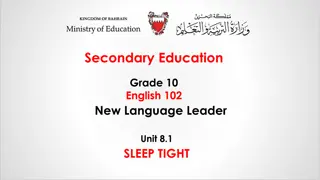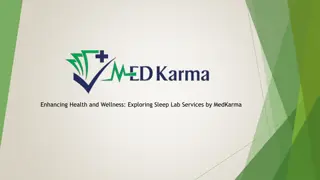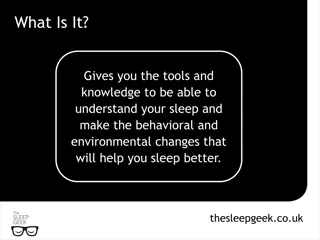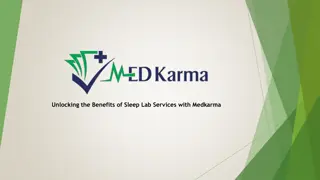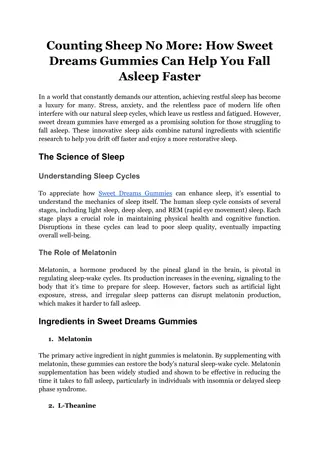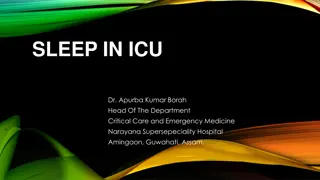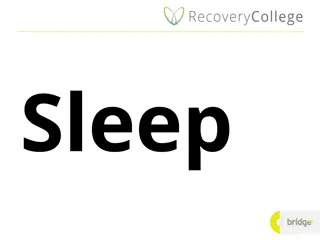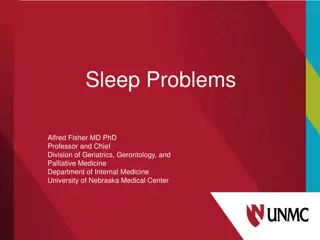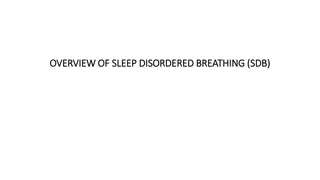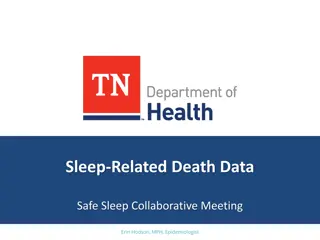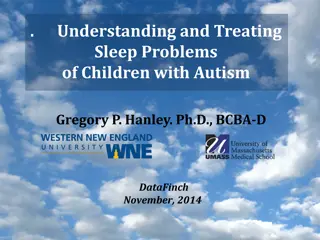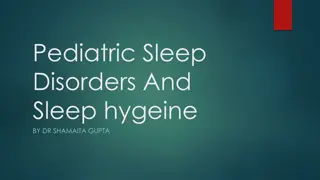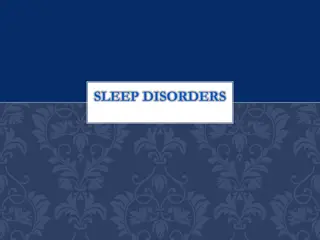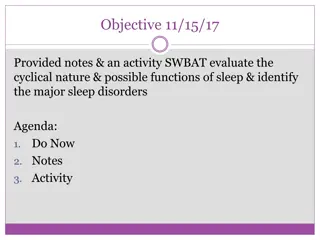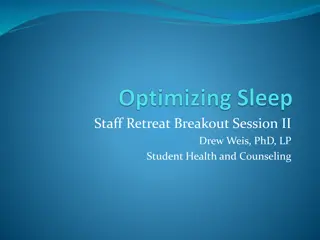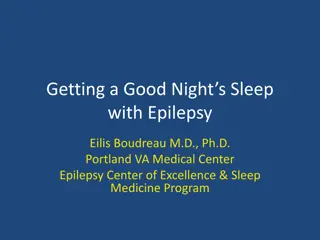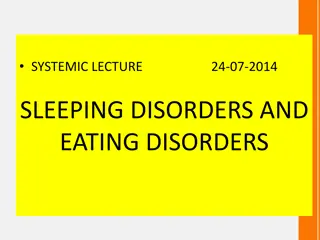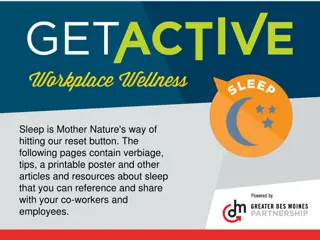Understanding Sleep Disorders in Children and Adolescents
This informative presentation by Dr. Rebecca Cho delves into the complexities of sleep architecture and physiology across different life stages. It explores various pediatric sleep disorders, their comorbidities, and the potential developmental consequences of sleep disruption. The discussion also covers behavioral and pharmacological treatment options, shedding light on the critical importance of addressing sleep issues in young individuals.
Download Presentation

Please find below an Image/Link to download the presentation.
The content on the website is provided AS IS for your information and personal use only. It may not be sold, licensed, or shared on other websites without obtaining consent from the author. Download presentation by click this link. If you encounter any issues during the download, it is possible that the publisher has removed the file from their server.
E N D
Presentation Transcript
SLEEP DISORDERS IN CHILDREN AND ADOLESCENTS Rebecca Cho, M.D.
O B J E C T I V E S Review of sleep architecture and physiology through life stages Exploration of pediatric sleep disorders and comorbidities Potential consequences of sleep disruption in development Behavioral and pharmacological treatment options
Normal Sleep Architecture NREM Stage 1 Transition stage where sleep usually begins, can be easily aroused Alpha waves, rhythmic = relaxed wakefulness 1-7 min in HR and respirations, eyes move slowly under eyelids Stage 2 Deeper sleep, more difficult to arouse 10-15 min initial cycle, longer with progressive cycles (45-55% total sleep) Sleep spindles and K-complexes memory consolidation, tranquil sleep Further in HR and respirations, no eye movement Sleep Disorders and Sleep Deprivation: An Unmet Public Health Problem. Institute of Medicine (US) Committee on Sleep Medicine and Research; Colten HR, Altevogt BM, editors. Washington (DC): National Academies Press (US); 2006. Klykylo, William M., Kay, Jerald, eds Clinical Child Psychiatry. 3rded. West Sussex: Wiley-Blackwell, 2012. Print.
Normal Sleep Architecture - Stages 3 and 4 (slow wave) o Deepest sleep, highest arousal threshold, may be disoriented if awakened o Stage 3 few min; stage 4 20-40 min o No significant distinguishing pattern in shift from stage 3 to 4 o Primarily delta waves = high voltage slow waves o Slowest rates of breathing and HR REM - Rapid eye movement - Atonia, muscle paralysis safe expression of dreams - Desynchronous low-voltage mixed frequency waves + mix of wave patterns seen in other sleep stages and wake state Sleep Disorders and Sleep Deprivation: An Unmet Public Health Problem. Institute of Medicine (US) Committee on Sleep Medicine and Research; Colten HR, AltevogtBM, editors. Washington (DC): National Academies Press (US); 2006. Klykylo, William M., Kay, Jerald, eds Clinical Child Psychiatry. 3rded. West Sussex: Wiley-Blackwell, 2012. Print.
Normal Sleep Architecture Stage 1 Stage 2 Stage 3 Stage 4 REM = one cycle - Cycle repeats through the night - NREM 75-80%, REM 20-25% of total sleep - First cycle 70-100 min; later cycles longer at 90-120 min - Stage 2 progressively dominates NREM and REM intervals get longer with subsequent cycles, while slow wave sleep largely disappears Differences in sleep architecture through the ages - Sleep becomes less efficient w/ age - Newborns o Sleep up to 16-18 hrs/day in broken segments lasting 2-4 hrs o No distinct stages, circadian rhythm not fully developed Sleep Disorders and Sleep Deprivation: An Unmet Public Health Problem. Institute of Medicine (US) Committee on Sleep Medicine and Research; Colten HR, Altevogt BM, editors. Washington (DC): National Academies Press (US); 2006. Klykylo, William M., Kay, Jerald, eds Clinical Child Psychiatry. 3rded. West Sussex: Wiley-Blackwell, 2012. Print.
Normal Sleep Architecture - By 2-3 mos o Circadian rhythm, NREM, REM develops o Progressive consolidation of sleep, naps, less total sleep required (14- 15 hrs) o Dreams more apparent by 12 mos, content tends to be more vague - Children o Total sleep further to 11-12 hrs by 3-5 y/o, most napping stops also o Slow wave tends to dominate sleep cycle (w/ associated GH release) o May start having more vivid dreams, nightmares, content related to waking thoughts/fears/desires - Adolescents o Need avg 8-10 hrs/night o in slow wave sleep w/ onset of puberty and into adulthood o Frequent shifts in circadian rhythm due to social/environmental factors and potential biological/hormonal s Sleep Disorders and Sleep Deprivation: An Unmet Public Health Problem. Institute of Medicine (US) Committee on Sleep Medicine and Research; Colten HR, Altevogt BM, editors. Washington (DC): National Academies Press (US); 2006. Klykylo, William M., Kay, Jerald, eds Clinical Child Psychiatry. 3rded. West Sussex: Wiley-Blackwell, 2012. Print.
Physiological s in Sleep Physiological Process NREM REM from wakefulness in motor and sensory areas; otherwise similar to NREM Brain activity from wakefulness and varies Heart rate from wakefulness up to 30 % and varies Blood pressure from wakefulness significantly from wakefulness Sympathetic nerve activity Muscle tone Similar to wakefulness Absent from wakefulness from NREM, depending on brain region Blood flow to brain from wakefulness and varies from NREM, but may show brief stoppages; cough suppressed Respiration from wakefulness and varies from wakefulness Airway resistance Body temperature Regulated at lower set point than wakefulness;; shivering initiated at lower set point than wakefulness Not regulated; no shivering or sweating; temp drifts towards that of local environment Sexual arousal Occurs infrequently > than NREM Sleep Disorders and Sleep Deprivation: An Unmet Public Health Problem. Institute of Medicine (US) Committee on Sleep Medicine and Research; Colten HR, Altevogt BM, editors. Washington (DC): National Academies Press (US); 2006.
Why Do We Sleep?? Exact role of sleep or why we alternate btwn NREM and REM are unclear, but overwhelming evidence that lack of sleep or disrupted sleep architecture leads to negative outcomes A lot of interest in research; some hypotheses have arisen REM - Appears to be involved in memory consolidation; learning seems to intensify/ REM - Hippocampal neuronal activation in REM mirrors pattern of wake state - NE and 5HT post-synaptic depolarization and long-term potentiation may aid in temporary hippocampal memory storage, cognitive functioning, synaptic plasticity NREM - Also appears to be associated w/ learning and memory; learning seems to intensify slow waves during NREM - May play role in differentiating/organizing important synapses from those that are underutilized, facilitate protein synthesis Poe, Gina R., Walsh, Christine M., Bjorness, Theresa E. Cognitive Neuroscience of Sleep. Prog Brain Res. 2010; 185:1-19.
Pediatric Sleep Disorders Obstructive sleep apnea Sleep-related movement disorders Parasomnias Narcolepsy Circadian rhythm disorders Behavioral insomnia of childhood Psychiatric causes Medical causes
Obstructive Sleep Apnea ETIOLOGY SYMPTOMS RISK FACTORS Adenotonsillar hypertrophy (most common) Snoring Allergies Apneic episodes Sinus problems Diaphoresis AA ethnicity Obesity Enuresis FHx of OSA Craniofacial dysmorphology (e.g., Downs) Waking up feeling unrested Daytime somnolence Neuromuscular d/o (e.g., CP) Morning HAs Cognitive dysfunction
Obstructive Sleep Apnea Has been associated w/ ADHD: proposed that intermittent hypoxia + fragmented sleep prefrontal dysfunction Dx: polysomnography + pulse ox Tx: - Wt loss - Adenotonsillectomy if indicated - Nasal CPAP - Leukotriene receptor antagonists (montelukast) - Intranasal corticosteroids (fluticasone spray) - External nasal dilator strips Moturi, Sricharan, Avis, Kristin. Assessment and treatment of common pediatric sleep disorders. Psychiatry (Edgmont). 2010 Jun; 7(6): 24-37. Thiedke, Carolyn. Sleep disorders and sleep problems in childhood. Am Fam Physician. 2001 Jan 15; 63(2): 277-28
Sleep-related Movement Disorders Rhythmic movement disorder Periodic limb movement disorder in sleep Restless leg syndrome Relationship between ADHD and PLMS/RLS
Rhythmic Movement Disorder AKA Jactatio Capitis Nocturna Repetitive, stereotyped movements, involvement of large muscle groups - Head banging o stress o Lying in prone/supine position o Most common in 1st yr o Boys > girls - Head rolling o More common, progressively declines w/ age - Body rocking o Child is usually on hands and knees rocking anterior posterior o More associated w/ pleasurable activities (e.g., listening to music) - Hypothesized to be mechanism of self-stimulation/self-soothing (mimicking cradling/rocking by parents) Moturi, Sricharan, Avis, Kristin. Assessment and treatment of common pediatric sleep disorders. Psychiatry (Edgmont). 2010 Jun; 7(6): 24-37. Thiedke, C. Carolyn. Sleep disorders and sleep problems in childhood. Am Fam Physician. 2001 Jan; 63(2): 277-285
Rhythmic Movement Disorder Most commonly seen in infants and children < 5 y/o Usually occurs when child is sleeping; occ stage 1 or 2 sleep prevalence in MR (esp older individuals) Dx: Thorough clinical eval + video polysomnography to r/o other causes (e.g., seizures) Tx: - Supportive; spontaneous resolution w/ age in most cases - If movements risk for injuries (esp head banging) provide safe environment (e.g., padding, protective helmets) - Metronome near bed - Allowing child to engage in rocking before bedtime (e.g., rocking on chair or rocking horse) - If severe, may trial low-dose benzo such as clonazepam Moturi, Sricharan, Avis, Kristin. Assessment and treatment of common pediatric sleep disorders. Psychiatry (Edgmont). 2010 Jun; 7(6): 24-37. Thiedke, C. Carolyn. Sleep disorders and sleep problems in childhood. Am Fam Physician. 2001 Jan; 63(2): 277-285
Periodic Limb Movements in Sleep (PLMS) Involuntary brief jerking movements in 20-40 sec intervals Lower > upper extremities In children movements may be less apparent; instead may present as: - Growing pains - Leg discomfort - Disrupted sleep - Difficulties initiating/maintaining sleep Moturi, Sricharan, Avis, Kristin. Assessment and treatment of common pediatric sleep disorders. Psychiatry (Edgmont). 2010 Jun; 7(6): 24-37. Thiedke, C. Carolyn. Sleep disorders and sleep problems in childhood. Am Fam Physician. 2001 Jan; 63(2): 277-285
Periodic Limb Movements in Sleep (PLMS) rate of parasomnias Dx: Video polysomnography to r/o seizures/OSA, detailed hx Tx options: - Fe supplementation (if low iron levels) - Dopaminergic agents (e.g., ropinirole, pramipexole) - Clonazepam (limited data) - Bupropion (shown to be effective for adult PLMS) Moturi, Sricharan, Avis, Kristin. Assessment and treatment of common pediatric sleep disorders. Psychiatry (Edgmont). 2010 Jun; 7(6): 24-37. Thiedke, C. Carolyn. Sleep disorders and sleep problems in childhood. Am Fam Physician. 2001 Jan; 63(2): 277-285
Restless Leg Syndrome (RLS) Frequently co-occurs w/ PLMS May p/w nonspecific growing pains or leg discomfort Criteria include: - Urge to move legs (may also involve upper ext) - Urge begins/worsens when sitting/lying/inactive - Urge partially or totally relieved upon movement of legs - Urge only occurs in evening/night or more severe than during daytime Sleep onset or maintenance difficulties frequent; anxieties r/t discomfort may interfere w/ ability to achieve restful sleep Moturi, Sricharan, Avis, Kristin. Assessment and treatment of common pediatric sleep disorders. Psychiatry (Edgmont). 2010 Jun; 7(6): 24-37. Thiedke, C. Carolyn. Sleep disorders and sleep problems in childhood. Am Fam Physician. 2001 Jan; 63(2): 277-285
Restless Leg Syndrome (RLS) Tx: - Behavioral interventions including strict sleep hygiene and reg physical activity - If Fe levels low (<50ng/dL) may consider supplementation (2mg/kg) w/ goal of ing > 50ng/dL + vit C to aid in absorption of Fe - Pharmacological options only approvde for adults; includes benzos, clonidine, gabapentin, dopaminergic agents (need to monitor closely for sedation) Moturi, Sricharan, Avis, Kristin. Assessment and treatment of common pediatric sleep disorders. Psychiatry (Edgmont). 2010 Jun; 7(6): 24-37. Thiedke, C. Carolyn. Sleep disorders and sleep problems in childhood. Am Fam Physician. 2001 Jan; 63(2): 277-285
Relationship Between ADHD & PLMS/RLS Significant comorbidity Possible hypotheses: - May be r/t impairment in DA pathway: Fe effectiveness of tyrosine hydroxylase DA production - Insufficient sleep in children (disrupted sleep commonly seen in those w/ PLMS & RLS) may manifest as hyperactivity, distractibility, inattention, impulsivity, cognitive impairments - ADHD-like sx may be diurnal manifestations of PLMS/RLS during daytime (difficulties staying seated or remaining inactive for extended periods of time and needing to move to decrease discomfort/urge) Fe supplementation has been shown to improve both PLMS & RLS sx at nighttime and some research showing improved ADHD-like sx during daytime Walters, Arthur S., Silvestri, Rosalia, Zucconi, Marco, Chandrashekariah, Ranju, Konofal, Eric. Review of the Possible Relationship and Hypothetical Links Between Attention Deficit Hyperactivity Disorder (ADHD) and the Simple Sleep-Related Movement Disorders, Parasomnias, Hypersomnias, and Circadian Rhythm Disorders. J Clin Sleep Med. 2008 Dec 15; 4(6): 591-600.
Parasomnias Largely seen in children Condition appears to spontaneous resolve w/ age, hypothesized to be 2/2 CNS immaturity Generally benign, though may be more impairing esp in older children if interfering w/ social functioning (e.g., sleepovers) NREM parasomnias: - AKA arousal disorders, result from sudden awakening from deep slow wave sleep, causing confusion and retrograde amnesia - Generally do not tend to respond to external stimuli - May be autonomic/motor hyperactivity (e.g., repetitive movements during sleep) - Often +FHx - Ex. sleepwalking, night terrors Moturi, Sricharan, Avis, Kristin. Assessment and treatment of common pediatric sleep disorders. Psychiatry (Edgmont). 2010 Jun; 7(6): 24-37. Thiedke, C. Carolyn. Sleep disorders and sleep problems in childhood. Am Fam Physician. 2001 Jan; 63(2): 277-285
Parasomnias REM parasomnias - No associated confusion, recall may be intact - Ex. nightmares, REM behavior d/o (more commonly seen in older adults), recurrent intermittent sleep paralysis Should r/o underlying seizures esp if duration is very short, +repetitive/stereotypic movements, inconsistent pattern in episodes Most common in children: - Sleepwalking - Night terrors - Nightmares - Nighttime enuresis Moturi, Sricharan, Avis, Kristin. Assessment and treatment of common pediatric sleep disorders. Psychiatry (Edgmont). 2010 Jun; 7(6): 24-37. Thiedke, C. Carolyn. Sleep disorders and sleep problems in childhood. Am Fam Physician. 2001 Jan; 63(2): 277-285
Sleepwalking (Somnambulism) Pathogenesis unknown Involves complex motor movements and cognitive functioning (e.g., ambulation, driving) Most frequently seen in pubescent children (peak prevalance 12 y/o) but can carry on to adulthood First third of sleep Triggered by psychological or physiological stress (e.g., sleep deprivation) rates in those w/ comorbid OSA, Tourette s, migraines Uncommonly violent/aggressive behaviors, but may become combative and agitated if attempted to be restrained during episode Moturi, Sricharan, Avis, Kristin. Assessment and treatment of common pediatric sleep disorders. Psychiatry (Edgmont). 2010 Jun; 7(6): 24-37. Thiedke, C. Carolyn. Sleep disorders and sleep problems in childhood. Am Fam Physician. 2001 Jan; 63(2): 277-285
Sleepwalking (Somnambulism) Tx: - Supportive, focus on ensuring child does not injure self during episode - Limit interference - Scheduled sleep awakenings - Psychotherapy (esp if episodes r/t stress) - Relaxation techniques - Pharmacotherapy: o Benzos o Antidepressants (only case studies, some may worsen condition 2/2 impairment in REM sleep) Moturi, Sricharan, Avis, Kristin. Assessment and treatment of common pediatric sleep disorders. Psychiatry (Edgmont). 2010 Jun; 7(6): 24-37. Thiedke, C. Carolyn. Sleep disorders and sleep problems in childhood. Am Fam Physician. 2001 Jan; 63(2): 277-285
Night Terrors (Pavor Nocturnus) First third of deep slow wave sleep Sx include: - Loud screaming and/or crying - Difficult to console - autonomic activity (e.g., tachycardia, tachypnea, sweating) - Intense feelings of panic/anxiety during episode Lasts 15-30 min Little to no recall of event May co-occur w/ sleepwalking Peak prevalence 3-7 y/o Frequent +FHx May be triggered by fatigue, stress Moturi, Sricharan, Avis, Kristin. Assessment and treatment of common pediatric sleep disorders. Psychiatry (Edgmont). 2010 Jun; 7(6): 24-37. Thiedke, C. Carolyn. Sleep disorders and sleep problems in childhood. Am Fam Physician. 2001 Jan; 63(2): 277-285
Night Terrors (Pavor Nocturnus) Two categories which differ in course of illness and tx approach Type A - Common - Benign, self-limiting - No tx required, parent reassurance Type B - Much less common - Frequently r/t trauma - Tends to be persistent throughout life - Resistant to tx - Tx options include low dose benzos (diazepam 2-5mg), impramine Moturi, Sricharan, Avis, Kristin. Assessment and treatment of common pediatric sleep disorders. Psychiatry (Edgmont). 2010 Jun; 7(6): 24-37. Thiedke, C. Carolyn. Sleep disorders and sleep problems in childhood. Am Fam Physician. 2001 Jan; 63(2): 277-285
Nightmares Common in both children and adults, but most common in children 3-6 y/o; persistence beyond this may warrant further exploration for underlying trauma, anxiety, mood disorder Must distinguish from night terrors Recall intact, not associated w/ confusion Second half of sleep in REM Tx: - Reassurance for parents - CBT (e.g., progressive muscle relaxation, dream scripting) - Pharmacotx for trauma-related nightmares (e.g., prazosin, clonidine) Moturi, Sricharan, Avis, Kristin. Assessment and treatment of common pediatric sleep disorders. Psychiatry (Edgmont). 2010 Jun; 7(6): 24-37. Thiedke, C. Carolyn. Sleep disorders and sleep problems in childhood. Am Fam Physician. 2001 Jan; 63(2): 277-285
Nocturnal Enuresis DSM V: Repeated involuntary bedwetting while sleeping 2x/wk for 3 consecutive mos or cause significant distress/impairment in child Toilet training complete by 4-5 y/o for most children Occurs proportionally throughout diff sleep stages Not associated w/ sleep disruption or arousal Two categories - Primary enuresis o No h/o consistent dryness through night > 1-2 wks o Strong +FHx o M > F o Neurodev delay o Probable delayed bladder control maturation, bladder irritation, primary detrusor muscle contraction Moturi, Sricharan, Avis, Kristin. Assessment and treatment of common pediatric sleep disorders. Psychiatry (Edgmont). 2010 Jun; 7(6): 24-37. Thiedke, C. Carolyn. Sleep disorders and sleep problems in childhood. Am Fam Physician. 2001 Jan; 63(2): 277-285
Nocturnal Enuresis - Secondary enuresis o Wetting episodes occur after sustained period (6-12 mos) of complete dryness o Majority of causes medical or psychological o Potential medical causes: a. Constipation b. DMI c. UTIs d. Seizures e. Hyperthyroidism f. Medication side effects (antipsychotics) o Potential psychological causes a. Death in the family b. Abuse/trauma c. Severe bullying - Sleep apnea proposed to be possible cause of both primary and secondary nocturnal enuresis; studies show adenotonsillectomy significantly or relieves enuretic episodes Moturi, Sricharan, Avis, Kristin. Assessment and treatment of common pediatric sleep disorders. Psychiatry (Edgmont). 2010 Jun; 7(6): 24-37. Thiedke, C. Carolyn. Sleep disorders and sleep problems in childhood. Am Fam Physician. 2001 Jan; 63(2): 277-285
Nocturnal Enuresis Extensive medical eval beyond PE and UA not necessary unless H&P c/w underlying medical d/o Tx - Behavioral modification first line tx: o Limit fluid intake in the evening o Bedwetting alarm o Bladder stretching exercises o Positive reinforcement through awards o Responsibility training o Visual sequencing - Pharmacological agents: o DDAVP o Oxybutynin o TCAs if refractory Moturi, Sricharan, Avis, Kristin. Assessment and treatment of common pediatric sleep disorders. Psychiatry (Edgmont). 2010 Jun; 7(6): 24-37. Thiedke, C. Carolyn. Sleep disorders and sleep problems in childhood. Am Fam Physician. 2001 Jan; 63(2): 277-285
Circadian Rhythm Disorders Delayed sleep phase syndrome - Sleep schedule lags behind environmentally expected sleep schedule - May be 2/2 genetics or habit - Teens > children - Tx: Systematc sleep deprivation - Motivational phase delay: When child has difficulties falling asleep and waking up 2/2 distress r/t daytime event (most commonly school); not due to physiological dyssynchrony of circadian rhythm, must target underlying issue causing distress Phase advance - Sleep schedule is earlier than environmentally expected sleep schedule - Less common than sleep delay - Tx: Progressively delay sleep time by 30-60 min at a time, shift activities later in the day (e.g., dinner time), until schedule adjusts - Tends to be easier to achieve due to 25-hr cycle of circadian rhythm Moturi, Sricharan, Avis, Kristin. Assessment and treatment of common pediatric sleep disorders. Psychiatry (Edgmont). 2010 Jun; 7(6): 24-37. Thiedke, C. Carolyn. Sleep disorders and sleep problems in childhood. Am Fam Physician. 2001 Jan; 63(2): 277-285
Circadian Rhythm Disorders Irreg sleep/wake patterns w/o consistent phase delay or phase advance - Caused by irreg schedules and lack of consistent structure at home - Tx focuses on helping parents develop structure in the home Some children may have shorter sleep cycles; these children generally do not have difficulties falling asleep or waking up in the AM Moturi, Sricharan, Avis, Kristin. Assessment and treatment of common pediatric sleep disorders. Psychiatry (Edgmont). 2010 Jun; 7(6): 24-37. Thiedke, C. Carolyn. Sleep disorders and sleep problems in childhood. Am Fam Physician. 2001 Jan; 63(2): 277-285
Behavioral Insomnias of Childhood Sleep-onset association disorder - Child has difficulties falling asleep independently - Relies on external interventions/circumstances; examples: o Rocking o TV o Being w/ parent o Being held o Sleeping in parents bed o Having bottle - Esp prevalent for infants who then associate falling asleep w/ parental support; then when waking up mid sleep has difficulties going back to sleep on his/her own - Tx o Awakenings shortly before predicted time the child will awake and progressively interval btwn awakenings o Remove the external cues, allow child to learn to sleep on their own Moturi, Sricharan, Avis, Kristin. Assessment and treatment of common pediatric sleep disorders. Psychiatry (Edgmont). 2010 Jun; 7(6): 24-37. Thiedke, C. Carolyn. Sleep disorders and sleep problems in childhood. Am Fam Physician. 2001 Jan; 63(2): 277-285
Behavioral Insomnias of Childhood Limit-setting disorder - Child repeatedly refuses to go to sleep at bedtime and parent allows them to stay up later - Allows excessive/dev inappropriate napping Combined type = Sleep onset association disorder + limit setting disorder Feeding-related disorder - Child must be fed when awakening from sleep in order to fall back asleep - Causes further disruptions in sleep r/t discomfort from bladder distention, diaper soiling Poor sleep hygiene Moturi, Sricharan, Avis, Kristin. Assessment and treatment of common pediatric sleep disorders. Psychiatry (Edgmont). 2010 Jun; 7(6): 24-37. Thiedke, C. Carolyn. Sleep disorders and sleep problems in childhood. Am Fam Physician. 2001 Jan; 63(2): 277-285
Psychiatric Causes Depression/mood disorders sleep issues - Early morning awakenings, incr sleep latency, interruptions/arousals, need for sleep, changes in sleep architecture - Tx underlying condition in addition to relaxation techniques, positive reinforcement strategies, limit setting, consistent bedtime schedules/routines Anxiety - Tx underlying condition in addition to behavioral/environmental interventions - At times strict limit setting may worsen anxieties/fears so parents must show understanding and compassion for child s distress and set limits more gradually in these cases Alcohol/drug abuse Moturi, Sricharan, Avis, Kristin. Assessment and treatment of common pediatric sleep disorders. Psychiatry (Edgmont). 2010 Jun; 7(6): 24-37. Thiedke, C. Carolyn. Sleep disorders and sleep problems in childhood. Am Fam Physician. 2001 Jan; 63(2): 277-285
Psychiatric Causes PTSD - Associated w/ specific parasomnias (e.g., nightmares, night terrors, enuresis) - Type 1: Acute specific trauma resulting in hyperautonomic arousal and insomnia - Type 2: Chronic trauma associated w/ hypersomnia - Tx for nightmares should be oriented more behaviorally (e.g., using dream scripting and trauma-focused CBT) vs meds such as prazosin given limited studies ADHD - Sleep issues hypothesized to be r/t combo of hypoarousal during day + compensatory hyperactivity to combat daytime hypoarousal and then inability to calm down at bedtime to fall asleep - Other factors include disruptions in baseline circadian rhythm, sensory integration difficulties, stimulant rebound effects, comorbid psychiatric d/o (e.g., anxiety) - If behavioral interventions ineffective/suboptimal, trial melatonin/alpha-agonist Moturi, Sricharan, Avis, Kristin. Assessment and treatment of common pediatric sleep disorders. Psychiatry (Edgmont). 2010 Jun; 7(6): 24-37. Thiedke, C. Carolyn. Sleep disorders and sleep problems in childhood. Am Fam Physician. 2001 Jan; 63(2): 277-285
Psychiatric Causes 5 factors seen in children w/ sleep issues > than those w/o - Family member who has experienced an accident/illness - Unaccustomed absence of mother - Mother w/ depressed mood - Co-sleeping - Maternal ambivalence towards child Moturi, Sricharan, Avis, Kristin. Assessment and treatment of common pediatric sleep disorders. Psychiatry (Edgmont). 2010 Jun; 7(6): 24-37. Thiedke, C. Carolyn. Sleep disorders and sleep problems in childhood. Am Fam Physician. 2001 Jan; 63(2): 277-285
Medical Causes Colic - Prolonged episodes of inconsolable crying, fussiness, and hypertonia (e.g., fist clenching, writhing/twisting movements, flapping, grimacing facial expressions) - Usually dev by 2-3 wks old, resolves by 4 mos - Hypotheses on etiology o CNS immaturity o Adaptive purpose of exercising infant lungs o Pain r/t gas o Cow s milk allergy o Insufficient progesterone levels - Studies showing potential sleep disturbance (e.g., arousals and shorter duration of sleep), difficult temperament, sensitivities to s in sleep sched in children who have outgrown colic o Possbily r/t parental overresponsiveness to child s needs during colic o Target by educating parents on importance of strict sleep hygiene Moturi, Sricharan, Avis, Kristin. Assessment and treatment of common pediatric sleep disorders. Psychiatry (Edgmont). 2010 Jun; 7(6): 24-37. Thiedke, C. Carolyn. Sleep disorders and sleep problems in childhood. Am Fam Physician. 2001 Jan; 63(2): 277-285
Medical Causes Medication side effects - Sedative/hypnotics: Associated w/ sleepwalking episdes, in particular non-benzos (e.g., zolpidemn, eszopiclone) - Sedative/hypnotics and antihistamines may cause residual daytime sedation - Antibiotics - Beta-blockers: Suppress nighttime melatonin secretion - Steroids: Cause imbalance in adrenal glands - SSRIs: Suppress REM sleep; some may also incr sleep latency and/or frequency of awakenings/arousals Moturi, Sricharan, Avis, Kristin. Assessment and treatment of common pediatric sleep disorders. Psychiatry (Edgmont). 2010 Jun; 7(6): 24-37. Thiedke, C. Carolyn. Sleep disorders and sleep problems in childhood. Am Fam Physician. 2001 Jan; 63(2): 277-285
Sleep Hygiene Integral part of tx for any sleep d/o Some differences depending on age Infants: - Fragmented and irreg sleep pattern c/w nl dev for newborns (up to 3-6 mos old) so parents should limit interference w/ sleep unless needed (e.g., getting on a plane) - As infant begins to consolidate sleep at night and responding more to external cues for sleep, parents should incorporate additional cues (e.g., waking them up earlier from daytime naps, minimizing disruptions at night while changing diapers by using low light) - Begin bedtime routine to help infant experience calm before sleep and ensure consistent routine in same order on nightly basis o Bath, PJs o Reading/humming o Changing diapers Moturi, Sricharan, Avis, Kristin. Assessment and treatment of common pediatric sleep disorders. Psychiatry (Edgmont). 2010 Jun; 7(6): 24-37. Thiedke, C. Carolyn. Sleep disorders and sleep problems in childhood. Am Fam Physician. 2001 Jan; 63(2): 277-285
Sleep Hygiene - Assist infant in learning to independently fall asleep in their own bed and remove parental presence as much as possible o Study by Anders and Keener showed 50% infants at 2 mos old able to fall asleep after arousal on their own o Allow infant to attempt to fall asleep on their own even if crying upon arousal If prolonged crying, parents may come to child and make eye contact to show support but no other interventions, and progressively increase interval of parental presence w/ subsequent arousals - By 6 mos need for nighttime feeding no longer present Start weaning nighttime feeding over 1-2 wks to avoid feeding-related d/o - Ensure comfortable environment for sleep o Warm blankets o Supine sleep position o Humidifier o Breathe Right strips for nasal congestion Moturi, Sricharan, Avis, Kristin. Assessment and treatment of common pediatric sleep disorders. Psychiatry (Edgmont). 2010 Jun; 7(6): 24-37. Thiedke, C. Carolyn. Sleep disorders and sleep problems in childhood. Am Fam Physician. 2001 Jan; 63(2): 277-285
Sleep Hygiene Older children/adolescents - Parents must reinforce consistent sleep sched, even on wknds - Bedroom should be reserved for bedtime ritual and sleeping only; no TVs, games, toys, computers, tablets, phones, etc. - Child should fall asleep in their own bed and alone - Avoid excessive physical activity near bedtime, though reg exercise earlier in the day may promote sleep - No daytime naps - Avoid caffeine or other stimulating substances - Avoid heaving eating or excessive drinking prior to bedtime - Avoid lying in bed unless sleepy - Provide cool, dark, quiet room - Must distinguish resistance to sleep from legitimate anxieties (e.g., school) b/c strict limit setting may exacerbate fears/worries; if this is the case must target underlying issue Moturi, Sricharan, Avis, Kristin. Assessment and treatment of common pediatric sleep disorders. Psychiatry (Edgmont). 2010 Jun; 7(6): 24-37. Thiedke, C. Carolyn. Sleep disorders and sleep problems in childhood. Am Fam Physician. 2001 Jan; 63(2): 277-285
General Pyschopharmacology First-line tx is always behavioral/environmental/sleep hygiene!!!! Medication Dosing Safety Concerns Pearls Alpha-agonists (clonidine, guanfacine) PO clonidine 0.05mg QHS (titrated by 0.05mg q5days) Cardiovascular risk at higher doses and overdose Guanfacine less sedating and has less anticholinergic/CV side effects vs clonidine PO guanfacine 0.5mg QHS (gradual titration by 0.5mg q5days) Guanfacine helpful in comorbid seizure d/o due to anticonvulsant effects; newer longer-acting formulation can be helpful in tx of ADHD and help w/ sleep maintenance REM suppression may occur, resulting in REM rebound upon d/c Often prescribed to target sleep onset delay in children w/ ADHD Moturi, Sricharan, Avis, Kristin. Assessment and treatment of common pediatric sleep disorders. Psychiatry (Edgmont). 2010 Jun; 7(6): 24-37.
General Psychopharmacology Medication Dosing Safety Concerns Pearls Melatonin and its receptor agonists (e.g. ramelteon) Clear dosing guidelines for melatonin unavailable in children Possible suppression of the hypothalamic-gonadal axis (caution in children w/ delayed puberty) Often prescribed to target sleep onset delay in children w/ ADHD and dev d/o 0.5-3mg/day (administered 2-3 hrs prior to sleep onset) More useful for chronobiotic rather than hypnotic properties (thus, useful in circadian rhythm sleep d/o) Effective doses may be higher in children w/ dev d/o (up to 10mg/day) Ramelteon (melatonin- receptor agonist) has limited data for use in children New agents (Agomelatine) can have potential uses in tx of comorbid anxiety and insomnia (due to melatonin agonist and 5HT antagonist properties) Moturi, Sricharan, Avis, Kristin. Assessment and treatment of common pediatric sleep disorders. Psychiatry (Edgmont). 2010 Jun; 7(6): 24-37.
General Psychopharmacology Medication Dosing Safety Concerns Pearls Antihistamines Diphenhydramine (0.5mg/kg up to max dose 25mg/day) Daytime drowsiness, dry mouth, urinary retention, paradoxical hyperactivity, cardiac toxicity in overdose Sedative effects through H1 receptor blocking properties Hydroxyzine (0.5mg/lb) Dev of tolerance requiring escalating doses Anxiolytic and anticholinergic properties of antihistamines can potentiate substance abuse in adolescents Benzodiazepines and benzodiazepine-receptor agonists (zaleplon, zolpidem, eszopiclone) Ultra-short half-life (zaleplon, 1-2hrs); short half- life (zolpidem, 2-3hrs); intermediate to long half-life (eszopiclone, 6hrs) Behavioral disinhibition and agitation w/ aggression and impulsivity, paradoxical hyperactivity Limited use in children 2/2 potential for abuse; none are approved for use in children by FDA Benzodiazepine-receptor agonsists have been shown to induce complex sleep- related behaviors (e.g., sleep eating and sleep walking); longer-acting medications (e.g., eszopiclone) are used mostly in adults 2/2 lack of dev of tolerance Moturi, Sricharan, Avis, Kristin. Assessment and treatment of common pediatric sleep disorders. Psychiatry (Edgmont). 2010 Jun; 7(6): 24-37.
General Psychopharmacology Medication Dosing Safety Concerns Pearls Antidepressants Trazodone at lower doses (12.5-50mg/day) Priapism w/ trazodone; tx- emergent anxiety and agitation; exacerbation of sx of RLS w/ TCAs; significant cardiotoxicity in overdose Most TCAs are potent REM sleep suppressants and suppress slow wave sleep TCAs (amitriptyline, nortriptyline) Should be used at the lowest possible doses to avoid cardiac side effects Sedating antidepressants (e.g., mirtazapine) have limited data in children; REM suppression by mirtazapine appears to be minimal Herbal supplements Chamomile, lavender, tryptophan, kava kava Necrotizing hepatitis (kava kava); eosinophilia myalgia syndrome (tryptophan) Use of herbal supplements have limited-to-no evidence of efficacy Moturi, Sricharan, Avis, Kristin. Assessment and treatment of common pediatric sleep disorders. Psychiatry (Edgmont). 2010 Jun; 7(6): 24-37.
Evaluation for Sleep Disorders Etiology of pediatric sleep d/o usually multifactorial Detailed hx most important Record sleep diary for 2 wks (e.g., http://yoursleep.aasmnet.org/pdf/sleepdiary.pdf) Questionnaires - Children s Sleep Habits Questionnaire (CSHQ) o Vaildated for 4-12 y/o o 33 items (41 points cut off) o http://www.education.uci.edu/childcare/pdf/questionnaire_interview/C hildrens%20Sleep%20Habits%20Questionnaire.pdf - Adolescent Sleep Hygiene Scale o 12-18 y/o o 28 items (no specific scoring) o Dev for evaluating healthy teens o http://sleep.colorado.edu/sites/default/files/ASHS_website_130303.pdf
Evaluation for Sleep Disorders Medical work-up - VS including BMI - Focused or comprehensive PE - Labs (e.g., Fe levels) - Polysomnography if suspecting primary sleep d/o Evaluation of Sleep Complaints and Pertinent Clinical Hx: Sleep Complaint Exploring Pertinent History Habitual bedtimes (sleep onset/offset on wkdays and wknds/holidays) Time taken to sleep onset; desired bedtime Duration, frequency, and severity of complaints Inappropriate nap schedules FHx Negative associations (fears, worries) w/ distressing sensorimotor sx of restless leg syndrome, nightmares Difficulty sleeping through the night (nighttime awakenings, early morning awakening); activities during the awakenings Screen for mood and anxiety sx Screen for primary sleep disorders (sleep apnea) FHx Use of alerting substances at bedtime Difficulty falling asleep Difficulty staying asleep (and/or multiple nocturnal awakenings) early morning awakenings Moturi, Sricharan, Avis, Kristin. Assessment and treatment of common pediatric sleep disorders. Psychiatry (Edgmont). 2010 Jun; 7(6): 24-37.
Evaluation for Sleep Disorders Sleep Complaint Exploring Pertinent History Total duration of nocturnal sleep Quality of morning awakenings Difficulty to stay awake in the classroom, while driving, watching TV, eating meals Persistent use of stimulants (e.g., nicotine, caffeine) to stay awake Exploring other potential sx associated w/ disorders of excessive sleepiness (e.g., cataplexy, sleep paralysis, sleep attacks, hallucinations) Daytime consequences of sleepiness (e.g., poor academic performance, learning difficulties, impaired concentration, disruptive behaviors, mood sx) FHx Medication use (long-acting psychotropic meds w/ hangover effects) Substance use (alcohol and other illicit drugs, OTC meds) Occupation (odd hrs at employment, shift-work schedules) Social environment (co-sleeping/sharing bedroom, sleep patterns of parents and other children, pets in bedroom) Housing (light, noise, temp) Activities at bedtime (computer/telephone, HW completion, TV viewing) Substance use (alcohol and other illicit drugs, caffeine intake, nicotine use, OTC meds) Parental involvement (limit setting, adult supervision) Excessive daytime sleepiness Poor sleep routine and sleep hygiene due to environment and psychosocial variables Moturi, Sricharan, Avis, Kristin. Assessment and treatment of common pediatric sleep disorders. Psychiatry (Edgmont). 2010 Jun; 7(6): 24-3
Ramifications of Sleep Deprivation Neurocognitive - Deficits in attention, memory, learning - Hyperactivity/impulsivity (more common in younger children) - Deficits in executive functioning - Daytime sedation Psychological - Depression/mood lability - Irritability - Oppositionality - Anxiety - Fatigue/weakness O Brien, Louise M. The neurocognitive effects of sleep disruption in children and adolescents. Child and Adolescent Clinics of North America. 2009 Oct; 18(4): 813-823


